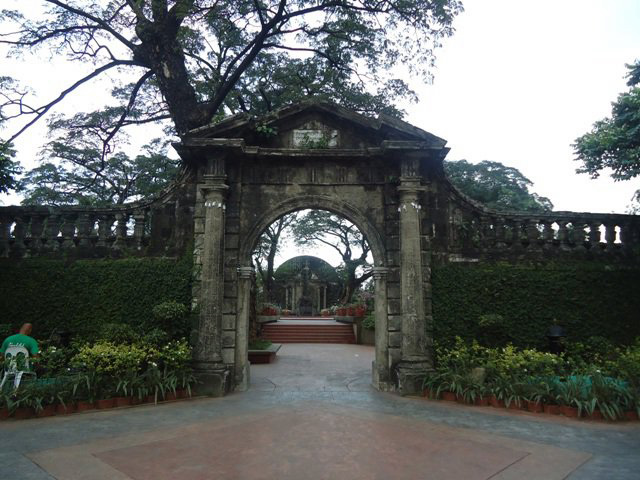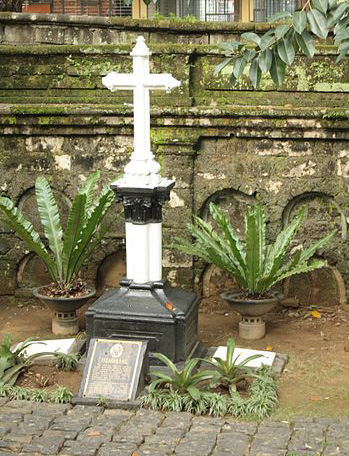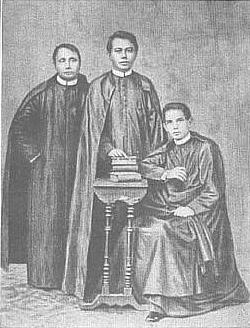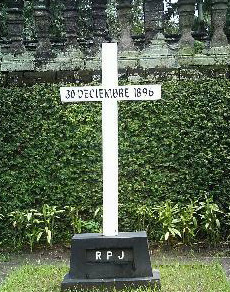Paco Park and Cemetery
Manila
Share this page:
The Paco Park and Cemetery is a beautiful and quiet spot in the suburb of Paco in Manila.
It is designed in a circular form -- in a structure of two concentric stone walls with a promenade on top -- with a rotunda church (St Pancratius) and old-fashioned gardens in the center.

The front gate of Paco Park and Cemetery
Built in 1820, the niches in the walls of Paco Cemetery received the bodies of the victims of the cholera epidemic of that year.
A former Spanish Governor General of the Philippines, Ramon Solano y Lladeral, and a number of bishops are buried in the cemetery.
Three priests, Fathers José A. Burgos, Mariano C. Gomez and Jacinto R. Zamora, who were executed in 1872 for their suspected role in the Cavite mutiny (a 19th century insurrection against Spanish rule), are buried in this Park. The priests (often referred to collectively as Gomburza) were an inspiration for later Filipino independence advocates such as José Rizal and are regarded as martyrs by the Philippine nation.

Burial site of Fathers Jose A. Burgos, Mariano C. Gomes and Jacinto R. Zamora

Fathers Jose A. Burgos, Mariano C. Gomes and Jacinto R. Zamora
The plaque in front of their burial site reads as follows:
MEMORARE
The mortal remains of the three martyred priests, Fathers Jose A. Burgos, Mariano C. Gomes and Jacinto R Zamora, were buried in this hallowed ground after their execution on 17 February 1872 for complicity in the Cavite mutiny.
This marker unveiled by His Excellency Fidel A. Ramos, President, Republic of the Philippines, February 17, 1998, on the occasion of the martyrdom of the three priests.

Shrine to Jose Rizal in Paco Park
In another corner of Paco Park is a shrine dedicated to the Philippines national hero, Dr José Rizal. The shrine consists of a wooden cross with the date of Rizal's death (30 deciembre 1896, that is, 30 December 1896) and, at its base, three letters -- R P J -- which are the initials of Rizal's name, José P Rizal, written in reverse order.
After Jose Rizal's execution the hero's body had been hurriedly taken away from Bagumbayan Field (now known as Rizal Park or Luneta) by the authorities. His sister Narcisa looked in cemeteries all over Manila, trying to find where the body had been taken. Finally in Paco Cemetery she noticed a newly dug plot with soldiers standing guard. The cemetery janitor confirmed that her brother's body had indeed been buried there and she arranged with him to put a plaque on the plot with her brother's initials written on it in reverse order (R P J) so as not to alert the Spanish authorities that the burial place had been discovered.
In 17 August 1898 five days after the Spanish had been ousted from Manila by the Americans, Jose Rizal's relatives exhumed the hero's remains from the Paco Cemetery plot and transferred them to the house of Rizal's mother in the Manila suburb of Binondo, where they remained until 30 December 1913 when they were reverently interred under the pedestal of the Rizal Monument in the Rizal Monument (Luneta).
The plaque at Rizal's burial site site in Paco Cemetery tells more of what happened at this place:
JOSE RIZAL
Executed 30 December 1896. Interred secretly in this spot by the authorities on the same day. Guarded for fifteen days by the Guardia Civil Veterana. Remains exhumed 17 August 1898. Placed in an urn made by Teodoro Romualdo de Jesus. Placed in the house of his mother in Estralde Street, Binondo and on 30 December 1913 laid beneath his monument at the Luneta.
Share this page:
Author: David Paul Wagner
(David Paul Wagner on Google+)